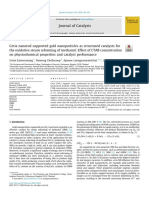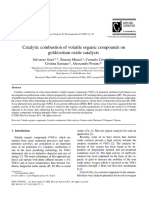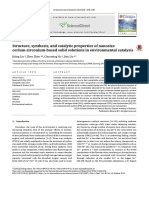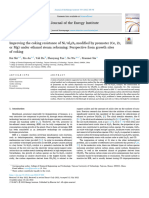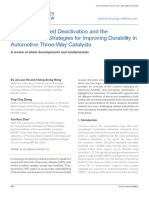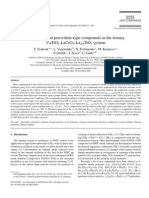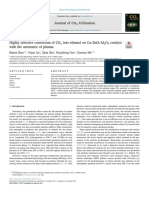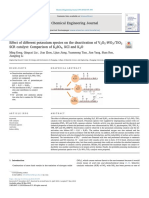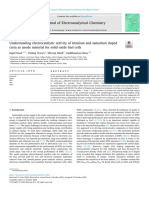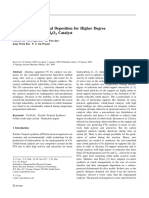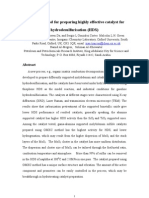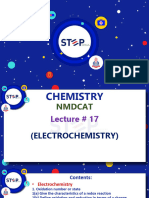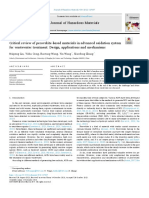Amool
Amool
Uploaded by
irfan k shahCopyright:
Available Formats
Amool
Amool
Uploaded by
irfan k shahOriginal Title
Copyright
Available Formats
Share this document
Did you find this document useful?
Is this content inappropriate?
Copyright:
Available Formats
Amool
Amool
Uploaded by
irfan k shahCopyright:
Available Formats
Applied Catalysis A: General 382 (2010) 7384
Contents lists available at ScienceDirect
Applied Catalysis A: General
journal homepage: www.elsevier.com/locate/apcata
An investigation of the role of Zr and La dopants into Ce1xy Zrx Lay O enriched -Al2 O3 TWC washcoats
A. Papavasiliou a , A. Tsetsekou a, , V. Matsouka b , M. Konsolakis b , I.V. Yentekakis b
a b
School of Mining Engineering and Metallurgy, National Technical University of Athens, Iroon Polytechniou, Zografou Campus, 15780 Athens, Greece Laboratory of Physical Chemistry and Chemical Processes, Department of Sciences, Technical University of Crete, 73100 Chania, Crete, Greece
a r t i c l e
i n f o
a b s t r a c t
This work involves the synthesis of composite three-way catalytic (TWC) washcoats consisting of 80 wt% of -alumina as the main supporting material, promoted with 20 wt% of ceria based solid solution. Pt in low loading (0.5 wt%) was employed as the only active phase. Washcoats varying in the solid solution composition (Cex Zry Laz O ), prepared by coprecipitation, are comparatively investigated in an attempt to elucidate the effect of Ce, Zr and La oxide promoters on the catalytic activity and thermal durability. For this purpose, catalytic activity measurements as well as detailed structural and morphological evaluations (differential thermal analysis (DTA), X-ray diffraction (XRD), N2 adsorption, oxygen storage capacity and DRIFTS analyses) were carried out before and after thermal aging in oxidative atmosphere. The catalytic performance was studied in loaded cordierite monoliths (TWCs form) under simulated exhaust conditions at the stoichiometric point. Doping ceria with Zr and La cation proved benecial for both catalytic performance and thermal durability of the washcoat, with Ce0.4 Zr0.5 La0.1 O1.9 / -Al2 O3 /Pt sample presenting the optimum properties. The catalytic behavior is discussed based on oxygen storage capacity, noble metal dispersion and textural characteristics of the examined samples. 2010 Elsevier B.V. All rights reserved.
Article history: Received 19 November 2009 Received in revised form 29 March 2010 Accepted 12 April 2010 Available online 18 April 2010 Keywords: TWCs Alumina Ceria Thermal stability Simulated exhaust conditions
1. Introduction Air pollution from automotive emissions still remains a major environmental problem. Nowadays, three-way catalytic converters employ a well established technology for the abatement of NOx , CO and hydrocarbon emissions of gasoline automotive engines. The most frequently used components in TWCs are ceria and ceria based oxides. These oxides are basically employed as promoters and oxygen storage materials [15]. Due to its nonstoichiometric behavior ceria can undergo rapid redox cycles (2CeO2 Ce2 O3 + O2 ) and act as an oxygen buffer by storingreleasing O2 under oxidizing (fuel-lean) and reducing (fuel-rich) conditions, respectively. This intrinsic property of ceria called oxygen storage capacity (OSC) compensates the oxygen partial pressure uctuations so as to maintain constant the air to fuel ratio (A/F) around the stoichiometric value where the highest conversion values of all pollutants, CO, hydrocarbons and NOx , are obtained [15]. The continuously increasing release of harmful emissions from the automotive engines rendered more strict emission control standards. The biggest challenge, in order to reach the new standards,
Corresponding author. Tel.: +30 210 7722213; fax: +30 210 7722119. E-mail address: athtse@metal.ntua.gr (A. Tsetsekou). 0926-860X/$ see front matter 2010 Elsevier B.V. All rights reserved. doi:10.1016/j.apcata.2010.04.025
is the conversion of pollutants during the period of the cold start emission. To this line, effort has been made to locate TWCs closer to the engine. As a result washcoat materials with enhanced thermal stability (stable to temperatures up to 1000 C) are now required. Pure ceria is seldom used at elevated temperatures due to its poor thermal stability, which causes a loss of specic surface area through changes in porosity and crystalline growth at temperatures above 900 C, attenuating its benecial properties [5,6]. It has been reported that addition of zirconium is the most effective way for ceria stabilization. Ceriazirconia solid solution exhibits higher OSC, improved redox properties, enhanced thermal resistance and catalytic action at low temperatures [14,710]. However, the signicant role of zirconium content in Ce/Zr solid solution on the TWC performance has been a matter of debate in the literature. According to previous studies of Kozlov et al. [11] and Silva et al. [12] high Zr content (4060 mol%), for which the Ce/Zr solid solution is compatible with the cubic symmetry, results in a more defective solid with enhanced redox and catalytic behavior. Opposite ndings were derived from the works of Trovarelli et al. [13], Thammachart et al. [14] and Gonzlez-Velasco et al. [15] who support that the optimum Zr content in CeO2 ZrO2 solid solutions is around 20 mol%. Finally after extensive investigation, Vidal et al. [16] found that high Zr content in CeO2 ZrO2 solid solutions accelerates the redox behavior with a reduction of the OSC due to the lesser Ce loading.
74
A. Papavasiliou et al. / Applied Catalysis A: General 382 (2010) 7384
Table 1 Classication of the samples with different oxide promoters and crystal phases detected by XRD investigation in the temperature range 6001100 C. Samples Molecular formula of mixed oxide Crystal phases detected by XRD 600 C Pt/A Pt/AC Pt/ACL Pt/ACZ Pt/ACZL CeO2 Ce0.8 La0.2 O1.9 Ce0.5 Zr0.5 O2 Ce0.4 Zr0.5 La0.1 O1.95 -Al2 O3 -Al2 O3 + C -Al2 O3 + CL -Al2 O3 + CZ -Al2 O3 + CZL 900 C -Al2 O3 + traces -Al2 O3 + Pt0 -Al2 O3 + C + Pt0 / -Al2 O3 + CL + Pt0 / -Al2 O3 + CZ + Pt0 / -Al2 O3 + CZL + Pt0 1000 C - + -Al2 O3 + Pt0 - + -Al2 O3 + C + Pt0 -Al2 O3 + CL + Pt0 -Al2 O3 + CZ + Pt0 -Al2 O3 + CZL + Pt0 1100 C -Al2 O3 + Pt0 - + -Al2 O3 + C + Pt0 -Al2 O3 + CL + Pt0 - + -Al2 O3 + CZ + Pt0 -Al2 O3 + traces -Al2 O3 + CZL + Pt0
Further improvement of the catalytic properties and thermal stability can be attained by the addition of trivalent cations M3+ (M = La3+ , Y3+ , Ga3+ ) in the CeO2 ZrO2 oxide mixture [9,1720]. Vidmar et al. [18] found that trivalent cations stabilize the CeO2 ZrO2 solid solution in the cubic form, by inducing bulk oxygen vacancies and thus releasing the stress generated by insertion of the smaller Zr4+ into the CeO2 lattice. Accordingly, He et al. [19] concluded that formation of oxygen vacancies by insertion of Y3+ ions in the lattice of Ce/Zr solid solution accounts for the enhanced oxygen mobility, redox behavior and catalytic activity. For operation at elevated temperatures a new generation of composite catalytic washcoat was developed consisting of alumina and CZ solid solution [2128]. Alumina is added in order to keep the CZ particles highly dispersed, inhibiting that way their coagulation and thus phase segregation upon elevated temperature. The stabilization effect between the alumina and CZ particles is mutual since CZ particles act as diffusion barriers limiting the contact of alumina particles and accordingly delaying the transformation of the metastable - to -Al2 O3 [24,26]. Usually, this composite washcoat is prepared by wet impregnation or conventional mixing techniques [22,23]. Only very recently [2426] the benets obtained when all the washcoat components are mixed simultaneously in molecular level by a coprecipitation method were revealed. The enhanced homogeneity achieved by this method increases the metalsupport interfacial sites, prevents Pt sintering [26] and thus favors the catalytic activity and thermal durability of the catalytic washcoat. In our previous works Ce, Zr and La oxide promoters were found to strongly enhance Pt/Al2 O3 catalytic activity [26,29]. However, these results were mainly explained based on catalysts surface behavior under simulated exhaust conditions by means of diffuse reectance infrared spectroscopy lacking of an adequate comparative investigation among the examined samples [29]. In the present work a systematic study is carried out in order to elucidate the inuence of different oxide promoters on catalytic activity and thermal durability as well as to correlate important physicochemical properties of promoted catalysts with their three-way catalytic performance. For this purpose, catalytic powders with different ceria based solid solutions, Cex Zry Laz O , were produced and properties such as microstructure, pore structure characteristics, oxygen storage capacity, noble metal dispersion in the fresh state and upon thermal aging at 900 C in oxidative atmosphere were evaluated. Composition of different Ce1xy Zrx Lay O solid solution was xed so as to keep constant cerium to lanthanum ratio at 4:1 in all lanthanum containing samples. Further, cordierite monoliths were coated with the as developed powders and catalytic activity measurements under simulated exhaust conditions at the stoichiometric point were acquired. 2. Experimental 2.1. Preparation of washcoated monoliths 2.1.1. Coprecipitation method Catalytic powders with ve different compositions were prepared by simultaneous coprecipitation. In each case the cat-
alytic support consisted of 80 wt% of -alumina and 20 wt% of Ce1xy Zrx Lay O mixed oxide. Coprecipitation was conducted in ve-necked round bottomed split reactor, which was t with a glass stirrer and a pH electrode. The precursor materials used were Ce(NO3 )3 6H2 O, Zr(NO3 )2 H2 O, La(NO3 )3 6H2 O and Al(NO3 )3 9H2 O (Alfa Aesar, 99.5%). Solutions of the above metal nitrates were prepared by dissolving appropriate quantity of each solid in 100 mL of distilled water in order to yield each time the desirable proportion between the oxide promoters. Solutions were mixed and the pH value was raised and kept at around 10 by adding NH4 OH (13.4 M) solution as neutralizing agent. The pH of the solution was measured using a HANNA 8417 pH meter combined with a pH electrode. At the end, the content of the reactor was ltered under vacuum. The resulting precipitates were dried at 110 C for 12 h and calcined at 600 C for 2 h. The heating rate, in this case, was 2 C/min. A classication of the produced samples with different composition of Ce1xy Zrx Lay O solid solution is given in Table 1. The different molar content among the oxide promoters was decided so as to keep constant the cerium to lanthanum ratio in every case at 4:1, whereas high Zr loading is preferred based on previous works demonstrating as the optimum Zr values those varying between 40 and 60 mol% [11,12]. In order to verify that the proportion of 80 wt% alumina and 20 wt% mixed oxides as well as the desirable ratio between the metals Ce:Zr:La were achieved during the coprecipitation synthesis, ICP measurements were conducted. For this purpose, solutions were assayed by inductively coupled plasma-atomic emission spectroscopy (ICP) using a Leeman Labs. Inc. instrument. After stabilization of the pH value of each solution (at 10) and ltration of the precipitate, 10 mL samples were collected and analyzed. The results conrmed that all the amount of the precursor solutions of the metals Ce, Zr, La and Al were precipitated. 2.1.2. Noble metal (Pt) addition For the addition of the active phase (Pt), the supports, in the form of powders, were impregnated in an aqueous solution of Pt(NH3 )2 (NO2 )2 (Aldrich 3.4 wt% in dilute ammonium hydroxide) with appropriate concentration so as to yield 0.5 wt% Pt loading in the nal catalytic materials. The resulted suspensions were stirred and heated at 80 C in order to remove the excess of water. The as formed pastes were then air dried overnight at 110 C and calcined at 600 C for 2 h. 2.1.3. Impregnation of cordierite monoliths by the washcoat materials For the washcoat preparation, stabilized slurries with 15 wt% solid content were produced. For slurry stabilization, a small amount of ammonium salt of the poly-methacrylic acid (NH4-PMA commercial name Darvan C, R.T. Vanderbilt Co., Norwalk, CT, USA) was used as dispersant. The slurries were ball milled with alumina grinding media for 24 h in order to reduce the size of agglomerates produced during heat treatment. Cylindrical cordierite monoliths, with 400 square cells/in.2 (manufactured by Corning, USA) and typical dimensions of 22 mm diameter and 10 mm length, were immersed in the stirring slurry for 1 min and dried at 110 C for
A. Papavasiliou et al. / Applied Catalysis A: General 382 (2010) 7384
75
1 h. The excess of slurry was removed by blowing air through the honeycomb channels. Five sequential impregnations were needed in order to achieve the desirable washcoat loading (20 0.5 wt% of the total monolith weight) and then the samples were calcined at 600 C for 2 h. The loading percentage was determined by the difference in weight of the monolith before and after its washcoating. The remaining slurry was dried and calcined at exactly the same conditions as the washcoated monoliths and the resulted powder was used for microstructural, morphological and pore structural characteristics evaluation by X-ray diffraction (XRD), TEM, N2 adsorption and DRIFTS. These samples (powder and monoliths) were hereafter designated as fresh. The aging treatment was performed on fresh samples (powder and monoliths) in a mufe furnace in static air at normal atmospheric pressure for a period of 5 h at 900 C. In order to further examine catalytic washcoats thermal stability, calcination treatments at 1000 and 1100 C for 5 h in static air were also carried out and the catalytic powders were characterized by XRD and N2 adsorption. Before acquisition of the catalytic activity measurements, the monolithic samples were heated in owing He (400 C/1 h/100 cm3 min1 ), followed by reduction with H2 (400 C/1 h/100 cm3 min1 ). 2.2. Catalyst characterization 2.2.1. X-ray diffraction The X-ray diffraction patterns were acquired on a Siemens D5000 diffractometer using nickel-ltered CuK 1 radiation (=1.54056 ), 40 kV voltage and 30 mA current. The following conditions were used: 0.02 /step with integration times of 13 s/step between 2 = 15 and 95 . The average particle size was calculated for the CeO2 (1 1 1) diffraction using the Scherrer equation. 2.2.2. N2 adsorption measurements BET surface area The nitrogen adsorption isotherms and BET surface areas were measured at 77 K with a Quantachrome Nova 1200 equipment. Specic surface area of the catalytic samples was determined by nitrogen physical adsorption using the BrunauerEmmettTeller (BET) method. Prior to the measurements the samples were degassed at 250 C for 2 h under vacuum. The pore size distribution was calculated from the BJH model (Barrett, Joyner and Halenda) using the desorption branch of the isotherm. 2.2.3. Differential thermal analysis (DTA) The thermal behavior of the two samples was examined in the temperature range 301300 C via differential thermal analysis in air ow at a heating rate of 10 C/min, with a Diamond Pyris (PERKIN ELMER) instrument. 2.2.4. OSC measurements Ultimate OSC was examined via thermogravimetry, with a Diamond Pyris (PERKIN ELMER) instrument, by monitoring the samples weight changes under cyclic heat treatment in owing air. The heat cycle consisted of a rst heat treatment up to 800 C, cooling to 150 C, and a second heat treatment to 800 C. The heating and cooling rates were 5 C/min. The weight loss of samples in the second stage of heat treatment was used as a measure of oxygen release properties. 2.2.5. Evaluation of Pt dispersion by means of IR spectroscopy In the present study the Pt dispersion was evaluated by a DRIFTS-aided method based on CO chemisorption, as described in detail in our previous report [26]. Diffuse reectance IR (DRIFTS) spectra were taken using an Excalibur spectrometer FTS 3000, equipped with an MCT detector cooled by liquid nitrogen and an IR
cell (Specac, Environmental Chamber DRIFT model) designed for in situ sample treatment. Spectra were obtained with a resolution of 2 cm1 and accumulation of 64 scans. During these measurements the external optics were purged with CO2 -free dry air generated from an air purier system (Claind Italy, CO2 -PUR model). Catalytic samples (80 mg) in powder form were placed in the IR cell and their surface was carefully attened in order to maximize the intensity of the IR beam. Before CO adsorption at room temperature, all samples were pretreated as follows: (i) heating to 400 C under He ow, (ii) reduction with 20%H2 /He at 400 C for 1 h, (iii) purging with He at 400 C for 30 min, (iv) cooled to room temperature under He ow, (iv) background spectra acquisition under He ow. After this treatment CO was introduced onto the reduced samples (0.5 kPa) and spectra were recorded until steady state (saturation of Pt sites with CO). Then the gas phase was evacuated and an infrared spectrum was collected from which the CO integrated area was estimated. 2.3. Catalytic activity measurements Catalytic activity measurements were carried out in a 300 mm long tubular quartz continuous ow reactor (24 mm i.d.), loaded with the monolithic catalyst (400 cells/in.2 and 4 cm3 volume) in the middle. A centred K-type thermocouple was used for the measurement of monolithic specimen temperature. Air Liquide certied gas mixtures 7.83% NO in He, 10.1% CO in He, 10% C3 H6 in He, 20.7% O2 in He and 100% CO2 , were used. These were further diluted in ultrapure He (99.999%) and supplied to the reactor at 1 bar. Reactant gases were delivered by a series of independent mass ow controllers (MKS type 247). The feed composition during catalytic experiments was typically 0.1% NO, 0.7% CO, 0.1067% C3 H6 and 0.78% O2 balanced with He. In some catalytic test experiments over representative samples this feed was further enriched with 10% H2 O and 10% CO2 , simulating better real exhaust conditions. The total gas ow rate was 3200 cm3 (STP)/min corresponding to a Gas Hourly Space Velocity (GHSV) of 50500 h1 . The redox characteristic of the simulated gas mixture was identied by the stoichiometric number S: S= 2[O2 ] + [NO] [CO] + 9[C3 H6 ]
For the reactants composition applied S was equal to unit, corresponding to stoichiometric point. The reactor inlet and outlet were analyzed using an online chemiluminescence NOx -analysis (Thermo Environmental Instruments 42C) for NO/NO2 analysis and an on-line Gas Chromatography (Shimatzu-14B) for CO, CO2 , O2 , N2 , N2 O and C3 H6 . In all catalytic activity measurements, the carbon and nitrogen balances were found to close within 5%. Before measurements were taken, the catalysts were operated for 1 day under the reactive gas mixture at 500 C to eliminate possible residue from the metal precursor and to ensure stable operation. The conversion performance of TWCs specimens was studied by increasing the reactor temperature in the interval of 50550 C which includes both the ignition and mean operating temperature of TWCs. At each step the temperature was held constant for at least 30 min before catalytic activity measurements. For comparison purposes, the catalytic performance of a TWC sample, with similar geometric characteristics to our TWC specimens, derived from a commercial bimetallic (Pt/Rh) TWC was also evaluated. As indicated by ED-XRF analysis, its total noble metal loading (0.37 wt% Pt + 0.08 wt% Rh) is 4.5-fold higher in comparison to that of as prepared Pt-only TWCs (0.1 wt% Pt on the basis of washcoated monoliths weight).
76
A. Papavasiliou et al. / Applied Catalysis A: General 382 (2010) 7384
Fig. 1. DTA proles between 800 and 1300 C for the samples: (A) Pt/A, (B) Pt/AC, (C) Pt/ACZ, (D) Pt/ACZL and (E) Pt/ACL.
Further, to test if the washcoating procedure affects the activity of catalytic powders, indicative (but not systematic) catalytic performance tests were performed on powder materials under similar reaction conditions as described above for the washcoated monoliths. Similar results were obtained in both cases (i.e., powder or washcoated monolith of the same chemical composition), implying that the intrinsic micro-structural characteristics of powder catalysts remain practically unaffected after washcoating. 3. Results and discussion 3.1. Microstructure and morphology characterization of the catalysts 3.1.1. DTA analysis results Differential thermal analysis was conducted in order to study the effect of the different oxide promoters in aluminas thermal stability. In Fig. 1, DTA proles, in the temperature range of 8001300 C, of the ve catalytic samples listed in Table 1 are presented. The samples examined were already calcined at 600 C for 2 h and their proles below the temperature of 800 C are not demonstrated due to the observed similarity (absence of peaks). In most cases only one exothermic peak is revealed at elevated temperature corresponding to -Al2 O3 phase crystallization, whereas peaks assigned to the -Al2 O3 phase formation could not be detected. The absence of unambiguous peaks of -Al2 O3 crystallization is consistent with the transformation mechanism which is based on the movement of aluminum atoms to interstitial sites by maintaining the same oxygen anion sublattice (fcc packing) in contrast to the transition which involves nucleation and grain growth phenomena for the oxygen rearrangement in the hcp packing [30,31]. As it can be observed from Fig. 1, in the reference sample Pt/A the transition to -Al2 O3 appears at about 1125 C, whereas for (CeZrLa)-enriched samples a signicant retardation, around 100 C, is noticed. More precisely, for Pt/AC and Pt/ACZ samples the exothermic peak is shifted at 1210 and 1205 C, respectively. ACZL sample exhibits even better thermal stability since the peak is located at higher temperature 1240 C. However, the superior behavior is demonstrated by Pt/ACL sample where no peaks could be detected, indicating a very strong delay of the transition to Al2 O3 above 1300 C. DTA results reveal the benecial effect of the oxide promoters in the alumina washcoats thermal durability and are further conrmed by the XRD analysis.
3.1.2. XRD results The XRD patterns of Pt/A, Pt/AC, Pt/ACZ, Pt/ACZL and Pt/ACL samples calcined in the temperature range of 6001100 C are presented in Fig. 2. By examining the patterns of the fresh samples (heat treatment at 600 C) (Fig. 2a) two phases can be distinguished: -Al2 O3 and a phase of cubic symmetry with reections typical of the uorite structure of CeO2 , corresponding to the (1 1 1), (2 0 0), (2 2 0) and (3 1 1) lattice planes. In the reference sample Pt/A only the phase of -Al2 O3 can be detected. In Pt/ACZ and Pt/ACZL samples, cerias diffractions are shifted to higher 2 values compared with Pt/AC sample, indicating the incorporation of Zr dopant cation into ceria lattice. Zr4+ (0.84 ) ionic radius is smaller than that of Ce4+ (0.97 ), therefore insertion of Zr into ceria lattice will cause a decline of the lattice constant and will shift peaks to higher 2 positions. In Pt/ACL sample the opposite trend is observed, cerias peaks are now shifted to lower 2 values which is attributed to the expansion of ceria lattice due to the larger radius of La3+ (1.16 ) with respect to Ce4+ (0.97 ). Peaks of crystallized Pt are not detectable due to the low Pt-particle size as veried by DRIFTS-aided measurements of Pt dispersion (see below). Upon thermal aging at elevated temperatures, structural modications in all samples are displayed, which mainly involve the transformation of -alumina and the appearance of Pt0 peaks. All the crystal phases detected for each sample are presented in Table 1. In the case of the unpromoted sample Pt/A, heat treatment at 900 C (Fig. 2b) for 5 h reveals all the characteristic peaks of -Al2 O3 with some trace peaks of -Al2 O3 . Further temperature increase at 1000 C (calcination period of 5 h) (Fig. 2c) demonstrates clear peaks corresponding to the two well crystallized phases of - and -Al2 O3 , whereas in the XRD pattern acquired at 1100 C (Fig. 2d) a complete conversion of -Al2 O3 into corundum structure is observed. Addition of the oxide promoters in the alumina washcoat signicantly alters the structural evolution upon thermal treatment. In the XRD pattern of Pt/AC sample calcined at 900 C, -Al2 O3 is the only phase noticed, whereas low intensity peaks of -Al2 O3 can be detected after heat treatment at 1000 C. With temperature rise to 1100 C -Al2 O3 is considered as the main alumina phase. In all the other samples promoted with a ceria-based solid solution thermal stabilization becomes more evident. Thus, -Al2 O3 is detected along with -Al2 O3 peaks after calcination at 1100 C in Pt/ACZ and Pt/ACZL samples, whereas in Pt/ACL sample -Al2 O3 remains the only detectable phase. As it can be deduced from Fig. 2 and Table 1, the thermal treatment of samples at the elevated temperature of 900 C affects Pt particles size, as in this case the detection of the characteristic Pt0 peaks (JCPDS No 87-0646) is made possible in all samples. This Pt grain growth is consistent with the -alumina transformation which facilitates migration and agglomeration of Pt particles. It is also worth mentioning the lack of detection of a pure lanthana or a zirconia-rich phase (phase of a t-symmetry) despite the elevated heating temperature. This fact, combined with the symmetrical shape of cerias shifted peaks retained in the temperature range 8001000 C, is an indication that no phase segregation of the Ce0.5 Zr0.5 O2 , Ce0.4 Zr0.5 La0.1 O1.95 and Ce0.8 La0.2 O1.9 solid solutions has occurred. According to Di Monte and Ka par [9], calcination at s 1000 C for 5 h of Cex Zr1x O2 followed by XRD analysis provides a rapid and accessible criterion for denition of a single phase product. In our case, phase homogeneity is attributed to several factors, such as the efciency and adequacy of the preparation procedure, the presence of the alumina washcoat and the presence of low-valent dopant cation such as lanthanum (in the case of Pt/ACZL sample). Alumina serves as a diffusion barrier by limiting the contact of the solid solution particles, thus delaying grain growth leading to the undesirable decomposition into ceriumand zirconium-rich stable phases [26,32]. Furthermore, lanthanum favors stabilization of CeO2 ZrO2 solid solution cubic structure by
A. Papavasiliou et al. / Applied Catalysis A: General 382 (2010) 7384
77
Fig. 2. XRD patterns after calcination at (a) 600 C for 2 h, (b) 900 C for 5 h, (c) 1000 C for 5 h and (d) 1100 C for 5 h, for the samples: (A) Pt/A, (B) Pt/AC, (C) Pt/ACL, (D) Pt/ACZ and (E) Pt/ACZL. (1 1 1), (2 0 0), (2 2 0), (3 1 1), (4 0 0), (3 3 1), (4 2 0), (4 2 2) and (5 1 1) ceria lattice planes are indicated. Phase indicator: Pt0 .
generating oxygen vacancies and thus releasing the stresses due to the unfavorable eight-fold coordination of Zr [18,32]. However, further increase of calcination temperature at 1100 C, in the case of high zirconium containing samples (Pt/ACZ and Pt/ACZL), revealed an asymmetry of cerias principle peak (asymmetry in larger 2 peaks cannot be clearly detected due to overlapping with alumina peaks), and more precisely a very low intensity shoulder around 29.5 which suggests the formation of a Zr-rich phase. This phase segregation is attributed to the signicant particle growth of Ce0.4 Zr0.5 La0.1 O1.95 and Ce0.4 Zr0.5 O2 metastable solid solutions (reaching or exceeding 15 nm, Fig. 7), which according to several authors is the driving force for their decomposition into thermodynamically stable phases [32]. As it can be derived, XRD results are in good agreement with DTA analysis, proving the benecial effect of the oxide promoters addition in the thermal stability of alumina washcoat with the following sequence observed: Pt/ACL > Pt/ACZL > Pt/ACZ > Pt/AC. It becomes evident that samples containing lanthanum quantities (>2 wt%) exhibit the optimum behavior in terms of thermal durability. It is well known that introduction of lanthanide cations, like La3+ , on a -alumina carrier is the most effective way of aluminas stabilization towards thermal sintering. However, the mechanism of aluminas stabilization by La is still under discussion [3336]. As recognized by many researchers, lanthanum loading and calcination temperature are crucial factors with great impact on aluminas thermal stability [3436]. For low La3+ loading and temperatures up
to 1100 C, lanthanum thermostabilizing effect was assigned to the formation of highly dispersed lanthanum species covering alumina surface [34,35]. Lanthanum cations occupy structural vacancies and therefore neutralize the surface defects, which are surface reactive aluminum ions, cus ions (strong Lewis acid sites). High La3+ loading leads to the formation of aggregates, which upon calcination above 800 C develop to perovskite lanthanum aluminate phase (LaAlO3 ) [34,35]. According to Oudet et al. [33] and Beguin et al. [34], perovskite lanthanum aluminate blocks surface aluminum ions into a thermally stable structure and therefore hinders surface diffusion processes leading to the transformation of to -alumina. In our case aluminas washcoat stabilization can be mainly ascribed to the presence of a small amount of lanthanum, possibly not fully incorporated into ceria lattice during coprecipitation, in a highly dispersed form covering the alumina surface, rather than to the formation of perovskite lanthanum aluminate phase. This conclusion is conrmed by the fact that no other lanthanum containing structure besides ceria based solid solution was detected by XRD analysis. The crystallite sizes of the oxide promoters solid solutions as a function of calcination temperature are presented in Fig. 3. As it can be seen, there are no great differences in the solid solutions crystallite sizes at the fresh state (calcination at 600 C). Whereas upon thermal aging, it is obvious that addition of dopant cations into ceria lattice decreases signicantly cerias grain size, i.e., Pt/ACZL sample exhibits almost the one third of the Pt/AC samples particle size. By
78
A. Papavasiliou et al. / Applied Catalysis A: General 382 (2010) 7384
Fig. 3. Crystallite sizes of ceria and ceria solid solutions vs. calcination temperature. Average particle size of the solid solution was calculated from the XRD patterns for the Ce1xy Zrx Lay O (1 1 1) diffraction using the Scherrer equation.
comparing the curves of Fig. 3, it can be suggested that zirconium addition has the most intrinsic effect on cerias crystal size. The fact that the addition of dopants with large ionic radii, such as La3+ (1.16 ), can further decrease the CeO2 ZrO2 solid solution particle size has been also reported in previous studies [21,37]. According to Pijolat et al. [38], thermal stabilization of ceria with lanthana addition is ascribed to the inhibiting effect of the larger lanthanum ions on diffusion processes leading to grain growth. Recent studies have also proved that cerialanthana solid solution upon thermal treatment exhibits a surface segregation of lanthanum as it was conrmed by XPS analysis [39,40]. This surface migration of the larger trivalent dopant cations, which is energetically favored, is considered responsible for ceria stabilization under oxidizing conditions [1,41,42]. Summarizing the ndings of the XRD analysis it can be derived that Zr4+ and La3+ dopant cations have a remarkable impact on washcoats thermal durability. The former strongly improves cerias stabilization by maintaining cerias crystal size under 15 nm even after aging at 1100 C, whereas the latter signicantly delays the undesirable transformation of -Al2 O3 . Both results are in complete agreement with DTA and pore structural analysis (see below). 3.1.3. Pore structure characteristics and BET surfaces area values The evolution of textural characteristics (BET surface area and pore volume) of catalytic samples as the calcination temperature increases (from 600 to 900 C and nally to 1100 C) is depicted in Table 2. Regarding the BET surface area (SBET ) it can be derived that Pt/A sample possesses the highest values upon calcination at 600 and 900 C. This is in accordance with literature data demonstrating that high loading with oxides of high specic weight and low porosity, such as CeO2 , will have as a result the decrease of aluminas surface area [43]. In this line, the lowest SBET values are obtained
by Pt/AC sample containing the highest CeO2 content. However, the promoted samples with high Zr content exhibit SBET values very similar to those of the reference sample, due to the significant cerias stabilization as mentioned above. Calcination at the elevated temperature of 1100 C causes a drastic drop of SBET values in all the catalytic samples examined with the unpromoted Pt/A sample presenting the highest degradation rate. As it was revealed by the XRD patterns of the latter sample, calcination at 1100 C rendered -Al2 O3 the predominant crystal phase. Pt/ACZ, Pt/ACZL and Pt/ACL samples after heat treatment at this elevated temperature possess similar SBET values around 30 m2 /g. These results are consistent with differential pore size distributions, PSDs (Fig. 4) and pore volume values (Table 2) which demonstrate a shift of the mean pore diameter to higher values combined with a decrease of the total pore volume as the calcination temperature is rising. This is more obvious in the case of the reference sample Pt/A, where calcination at 1100 C causes a drastic loss of the pore volume. The annihilation of porosity in the latter sample is ascribed mainly to -Al2 O3 transformation but also to sintering due to the collapse of small radii pores. By comparing the PSD curves of the doped samples (Fig. 4) it can be observed that Pt/ACZL sample possesses the narrowest PSD after calcination at 1100 C. To conclude, textural characteristics are signicantly improved by the addition of the oxide promoters in the alumina washcoat; an open pore structure and high SBET values are still kept at the elevated temperature of 1100 C in the promoted samples. Among the different oxide promoters higher thermal stabilization is observed for the samples with high Zr loading. Particularly, Pt/ACZL sample exhibits the optimum textural behavior since after calcination at 1100 C it demonstrates the same pore volume as the samples Pt/ACL and Pt/ACZ but higher surface area due to the stronger contribution from smaller radii pores. As already discussed in the XRD analysis, smaller ceria based solid solution particle size can account for the enhanced textural properties of Pt/ACZL sample. 3.1.4. Platinum dispersion Noble metal dispersion is considered as a property of major importance for the performance of a catalytic system, as it refers to the metallic surface area available for surface catalytic reactions. In catalytic systems, where the supporting material consists of a mixed carrier with signicant amounts of CeO2 , many problems in the determination of metal dispersion with H2 or CO chemisorption methods originate from the ability of the support to adsorb large quantities of these gasses [44]. Therefore an advanced method based on CO chemisorption with a direct measurement of the amount of CO adsorbed on Pt by means of DRIFT spectroscopy is applied in order to overcome the difculties of estimating Pt dispersion. This DRIFTS-aided method based on CO chemisorption is described in detail in our previous work [26]. In brief, the amount of CO adsorbed only on Pt sites was initially determined by means of DRIFT spectroscopy; then this amount was directly correlated to Pt dispersion values via a calibration curve obtained over a series of well characterized Pt/Al2 O3 samples with different dispersion [26]. The values of Pt dispersion of the ve catalytic samples at the fresh state and after thermal treatment at 900 C, as well
Table 2 Textural characteristics and BET surface areas of the catalytic samples at different calcination temperatures. Sample Pt/A Pt/AC Pt/ACL Pt/ACZ Pt/ACZL SBET at 600 C (m2 /g) 203 181 196 194 195 SBET at 900 C (m2 /g) 114 78 74 95 95 SBET at 1100 C (m2 /g) 12 19 28 30 33 Total pore volume at 600 C (cc/g) 0.4 0.3 0.4 0.35 0.4 Total pore volume at 900 C (cc/g) 0.36 0.28 0.34 0.34 0.33 Total pore volume at 1100 C (cc/g) 0.03 0.07 0.14 0.14 0.13
A. Papavasiliou et al. / Applied Catalysis A: General 382 (2010) 7384
79
declaring the benecial effect of ceria based oxides in promoting and stabilizing noble metals dispersion under oxidative atmosphere [4547]. It is worth mentioning, that among the promoted samples great differences in metal dispersion can be detected, revealing the strong impact of the support composition. More precisely, according to Table 3, Pt dispersion follows the order: Pt/ACL > Pt/AC > Pt/ACZ > Pt/ACZL, with samples Pt/AC and Pt/ACL demonstrating almost two-fold Pt dispersion values compared to samples Pt/ACZ and Pt/ACZL. It becomes evident that by decreasing cerias content in the oxide promoters solid solutions, Pt agglomeration is facilitated. The enhanced dispersion of the active phase when signicant amounts of ceria are introduced into the catalytic carrier is explained by means of noble metalsupport interactions. Several studies have addressed cerias ability to stabilize Pt in a high oxidation state under aging in oxidative atmosphere preventing severe sintering phenomena [2,3,4547]. Cerias intrinsic property is attributed to the high redox potential of the Ce4+ /Ce3+ couple (1.61 eV) compared to those of Pt2+ /Pt0 (1.19 eV) and Pt4+ /Pt2+ (1.05 eV) couples [47]. It is well known that thermal treatment at elevated temperature and under oxidizing conditions accelerates noble metal grain growth through processes of crystallite and molecular migration (species such as PtO) [48]. When Al2 O3 is used as catalytic support, PtOx easily decomposes to Pt metal under oxidizing conditions above 600 C due to weak noble metalsupport interactions and thus the very mobile Pt atoms formed facilitate sintering phenomena [45,49]. On the contrary ceria inhibits surface migration of metal atoms by anchoring them through localized chemical bonds involving sharing oxygen bonds. Therefore, formation of surface complexes through Pt2+ OCe4+ linkages preserves Pt in highly dispersed form. Apart from electronic interactions another model concerning geometrical effects is also suggested by Sanchez and Gazquez [50]. According to the authors, interactions of the noble metals with uorite type oxide supports refer to nesting of metal atoms into surface oxygen vacancies resulting in high metal dispersions. A burial effect is prevented due to the compact cation sublattice which serves as a diffusion barrier of the metal into the bulk. Based on the above mentioned points, the observed trend of the different promoted samples in Pt dispersion is completely justied. Pt/ACZ and Pt/ACZL samples contain much less Ce content and therefore present the lowest dispersion values. In this respect, Pt/AC and Pt/ACL samples exhibit the highest Pt dispersion. Between them, Pt/ACL sample besides the PtOCe interactions possesses the extra advantages of PtOLa interactions [51] and the generation of additional extrinsic oxygen vacancies in ceria based solid solution (so as to maintain the electrical neutrality) serving as valley positions for metal nesting, which explain its superior behavior. 3.1.5. Oxygen storage capacity A thermogravimetry method, already reported in the literature [5254], was applied in order to estimate the total oxygen storage capacity of the catalytic samples calcined at 600 C (fresh) and 900 C (aged). According to this method, the samples are tested under cyclic heat treatments and their weight changes are monitored in owing dry air in the temperature range of 300800 C. In the rst heat treatment a large decrease of weight was detected, assigned to the loss of surface water molecules and oxygen from ceria based solid solutions. The cooling back stage caused a recovery of weight, whereas in the second heat treatment a small weight loss was again observed. The weight loss, monitored in the second heating stage in the temperature interval between 300 and 800 C, was used to evaluate the potential oxygen release capacity of the samples in ordinary air atmosphere [5254]. The percentage weight loss and the respective total OSC values in terms of moles of O2 /g of cerias solid solution (s.s.) are presented in Table 3. By examin-
Fig. 4. Differential pore size distribution (dV dlog D) curves for Pt/A, Pt/AC, Pt/ACL, Pt/ACZ and Pt/ACZL samples after calcination at (A) 600 C for 2 h, (B) 900 C for 5 h and (C) 1100 C for 5 h.
as the respective Pt crystal sizes are summarized in Table 3. As it can be observed from the results of Table 3, the reference sample Pt/A displays very poor Pt dispersion only 10% after calcination at 600 C which strongly deteriorates to 2% upon heat treatment at 900 C in static air. On the contrary the promoted samples exhibit much higher dispersion values at both calcination temperatures, which is consistent with previous studies
80
A. Papavasiliou et al. / Applied Catalysis A: General 382 (2010) 7384
Table 3 Weight loss with the corresponding OSC ( mol O2 /g s.s.) values and Pt dispersion values with the respective crystallite sizes, vs. calcination temperature. Samples Weight loss % at 600 C 0.51 0.61 0.67 0.6 OSC ( mol O2 /g s.s.) at 600 C 581.4 940.2 1050.1 954.3 Weight loss % at 900 C 0.21 0.21 0.3 0.29 OSC ( mol O2 /g s.s.) at 900 C 319.8 323.2 474.2 443.1 Pt dispersiona (%) at 600 C 10 82 96 59 52 Pt dispersiona (%) at 900 C 2 53 56 25 19 Mean crystallite sizeb (nm) at 600 C 14 1.7 1.3 2.4 2.7 Mean crystallite sizeb (nm) at 900 C 68 2.6 2.5 5.6 7.4
Pt/A Pt/AC Pt/ACL Pt/ACZ Pt/ACZL
a b
Calculations based on DRIFTS-aided titration method. Calculations based on Pt surface atom density of 1.53 1019 atoms/m2 [25].
ing the data of Table 3, it becomes obvious that at the fresh state insertion of dopant cations, such as Zr4+ and La3+ , into ceria lattice strongly improves the OSC, whereas the observed trend among the doped samples in terms of higher OSC values follows the sequence: Pt/ACZ > Pt/ACZL > Pt/ACL > Pt/AC. Thermal aging at 900 C for 5 h induces a large reduction of the OSC in all the examined samples whereas at the same time the differences detected among the OSC values of the doped samples are enlarged. By far, the more pronounced enhancement of total OSC is achieved by the Zr doped samples whereas the Zr-free samples, Pt/AC and Pt/ACL, exhibit almost the same OSC values. Textural or morphological differentiations cannot account for the observed differences among the OSC values of the promoted samples, since the La- or Zr-doped samples (Pt/ACL, Pt/ACZ and
Pt/ACZL) which display superior OSC behavior at the fresh state they also possess similar specic surface area values and particle sizes with the pure ceriaalumina sample (Pt/AC) which yields the lowest OSC values. The small impact of surface area on total OSC is expected given that the total OSC is referred as the amount of oxygen thermodynamically available under redox reactions [4]. Another factor which cannot be correlated to the OSC is Pt dispersion. Based on the noble metals ability to act as a porthole for releasing oxygen from ceria solid solution due to the electronic interactions between Ptceria oxides, enhancement of the reduction properties should be expected [4,55]. On the contrary, Pt/AC and Pt/ACL samples which exhibit the highest dispersion values after both heat treatments (at 600 and 900 C), demonstrate the lowest OSC.
Fig. 5. NO (A), CO (B) and C3 H6 (C) conversion proles vs. temperature and corresponding N2 -selectivity (D) for the ve fresh catalysts listed in Table 1. Reaction conditions: 0.1% NO + 0.7% CO + 0.1067% C3 H6 + 0.78% O2 balanced with He at 1 bar. Total ow rate = 3200 cm3 (STP)/min.
A. Papavasiliou et al. / Applied Catalysis A: General 382 (2010) 7384
81
Fig. 6. NO (A), CO (B) and C3 H6 (C) conversion proles vs. temperature and corresponding N2 -selectivity (D) for the ve aged catalysts (calcined at 900 C) listed in Table 1. Reaction conditions: 0.1% NO + 0.7% CO + 0.1067% C3 H6 + 0.78% O2 balanced with He at 1 bar. Total ow rate = 3200 cm3 (STP)/min.
Based on the above remarks it can be derived that the total OSC is mainly inuenced by the nature of the dopant cations which strongly alter the bulk oxygen diffusion. The highest oxygen storage capacity of the samples Pt/ACZ and Pt/ACZL obtained at both calcination temperatures can be attributed to the induced structural defects (Frenkel-type anion defects) by Zr4+ incorporation into ceria lattice [4,7,5658]. Regarding lanthanum addition into ceria lattice, it has been already discussed that it generates additional anion vacancies resulting in an improved ionic conductivity and thus favoring bulk oxygen diffusion [59,60]. However, high lanthanum loading into ceria lattice (20 wt%) facilitates the formation of defect associates; vacancy traps are formed due to the attractive interactions between anion vacanciesdopant cations inhibiting in this way oxygen diffusion [17,18,61,62]. In line with these observations, Pt/ACL sample provided smaller OSC compared to the rest ceria doped samples. 3.2. Catalyst performance under simulated exhaust conditions Fig. 5 depicts the results of three-way catalytic conversion (AC) and N2 -selectivity (D) of fresh monolithic samples, under simulated exhaust conditions at the stoichiometric point. By comparing the catalytic performance at the fresh state, it is obvious that the reference sample Pt/A exhibits the lowest activity reaching conversion values of the order of 50%, 80% and 65% for the NO, CO and C3 H6 pol-
lutants, respectively, combined with limited selectivity towards N2 (6070%). Modication of the Al2 O3 support with oxide promoters signicantly enhances the overall conversion and selectivity performance, with the extent of promotion being strongly depended on the nature of oxides. A slight improvement is observed for the sample Pt/AC which yields NO, CO and C3 H6 conversions of 61%, 83% and 71%, respectively, and 78% N2 -selectivity at 500 C. Superior behavior is attained by the samples promoted with ceria based solid solutions through the incorporation of Zr4+ and La3+ into ceria lattice. Therefore, samples Pt/ACZ, Pt/ACL and Pt/ACZL exhibit higher catalytic activity with the latter providing the best performance reaching 100% conversion for all the pollutants and 97% selectivity towards N2 at 500 C. The results of the catalytic activity of the thermally aged samples, subjected to heat treatment at 900 C for 5 h, are plotted in Fig. 6AD. As it can be detected from the conversion proles, thermal aging caused a signicant degradation of the catalytic performance in all samples. Nevertheless, the extent of thermal deactivation differs among the catalytic samples examined. The reference sample Pt/A displays almost complete deactivation giving NO, CO and C3 H6 conversions lower than 20%, whereas the N2 -selectivity remains unaffected (73% maximum value). Sample Pt/AC presents slightly improved conversion values and light-off temperatures close to those of the unpromoted sample. In contrast Pt/Al2 O3 catalysts doped with Ce0.5 Zr0.5 O2 , Ce0.8 La0.2 O1.9 or
82
A. Papavasiliou et al. / Applied Catalysis A: General 382 (2010) 7384
Fig. 7. Conversion performance of fresh Pt/ACZL and commercial TWCs: (A) conversion values at 450 C and (B) light-off temperatures, under simulated exhaust conditions with and without H2 O and CO2 . Reaction conditions: 0.1% NO + 0.7% CO + 0.1067% C3 H6 + 0.78% O2 + (10% H2 O + 10% CO2 ) balanced with He at 1 bar. Total ow rate = 3200 cm3 (STP)/min.
Fig. 8. Conversion performance of aged Pt/ACZL and commercial TWCs: (A) conversion values at 450 C and (B) light-off temperatures, under simulated exhaust conditions with and without H2 O and CO2 . Reaction conditions: 0.1% NO + 0.7% CO + 0.1067% C3 H6 + 0.78% O2 + (10% H2 O + 10% CO2 ) balanced with He at 1 bar. Total ow rate = 3200 cm3 (STP)/min.
Ce0.4 Zr0.5 La0.1 O1.95 solid solutions exhibit much higher NO, CO, and C3 H6 conversions as well as N2 -selectivity over the whole temperature range investigated. The practical merit of as prepared fresh Pt-only TWCs can be revealed from Fig. 7A and B which depict the NO, CO and C3 H6 conversion values at a typical TWC operation temperature of 450 C and the light-off temperatures (i.e., the temperature for 50% conversion), respectively, for the optimally modied Pt/ACZL monolith and for a commercial bimetallic (Pt/Rh) TWC under reaction conditions, which involve or not H2 O and CO2 in the feed composition. It is obvious that in the absence of H2 O and CO2 from the reaction mixture, commercial TWC demonstrates superior conversion performance, attaining NO, CO and C3 H6 conversions of 97%, 100% and 96%, respectively, whereas the relevant values over Pt/ACZL are 90%, 97% and 93% (Fig. 7A). Concerning light-off temperatures, the same trend is kept as shown in Fig. 7B. More precisely, NO, CO and C3 H6 light-off temperatures are equal to 330, 296 and 320 C, respectively, for the commercial TWC and 365, 343 and 367 C for Pt/ACZL sample. However, under reaction conditions simulating better the real exhaust stream (i.e., in the presence of 10% H2 O and 10% CO2 in the reaction mixture) the situation is apparently inversed: Pt/ACZL appears to be more active offering at 450 C conversion values of 100% for all three NO, CO and C3 H6 pollutants, in contrast to the lower values of 97%, 95% and 93% obtained respectively by the commercial TWCs (Fig. 7A).
Analogous results concerning the catalytic performance of the aged commercial and Pt/ACZL TWCs are depicted in Fig. 8 A and B. The conclusions are also similar: the better catalytic performance of commercial TWC in the absence of H2 O and CO2 in the feed stream is still valid. Nevertheless, this situation is again inversed when 10% H2 O and 10% CO2 are co-fed in the reactant mixture; the aged Pt/ACZL catalyst displays superior catalytic performance in terms of both reactants conversion at 450 C (Fig. 8A) and light-off temperatures (Fig. 8B). From the extensive investigation of this work and by correlating the morphological, structural properties, oxygen storage capacity and metal dispersion with the catalytic performance, very useful remarks can be attained. Based on the results of DTA, XRD and N2 adsorption which revealed similar textural modication of the alumina carrier by the different oxide promoters in the temperature range of 600900 C, it can be derived that different textural and morphological characteristics cannot account for the differences in catalytic performance among the promoted samples. A more elevated temperature (1100 C) is needed in order to elucidate the effect of the different oxide promoters in aluminas pore structure and thermal stability. On the other hand, signicant variations in total oxygen storage capacity and metal dispersion values are detected among the modied catalytic samples. By comparing the catalytic performance with noble metal dispersion it can be realized that the latter is not an important parameter in this case, since sample Pt/AC which
A. Papavasiliou et al. / Applied Catalysis A: General 382 (2010) 7384
83
exhibits almost two-fold Pt dispersion values compared to samples Pt/ACZ and Pt/ACZL, at both calcination temperatures, yields much lower activity. Although, the number of active sites per g of catalyst (or equivalently the metal dispersion) is in principle a crucial factor for its conversion activity, it seems here that other factors have a more pronounced role. Obviously electronic type interactions between metal and support (metalsupport interactions), resulting in more active sites in terms of their turnover frequency (TOF), could be taken here into account [63]. In our recent in situ DRIFT studies in similar systems we have shown that Ce based mixed oxides incorporation into a Pt/ -Al2 O3 TWC results in a signicant modication of Pt surface chemistry [64]. Furthermore, the results show that the catalytic behavior strongly depends on the oxygen storage capacity as samples exhibiting the highest OSC display the optimum catalytic performance. It can thus be derived that an easily reducible ceriabased solid solution, able to provide lattice oxygen to the metalsupport interface which is considered to highly activate the oxidation of hydrocarbons and carbon monoxide, signicantly enhances catalytic activity [65]. Therefore, it can be suggested that the nature of the interfacial sites proved to be far more important than the number. Finally, regarding Pt/ACL sample it should be noted that it provides higher activity and thermal stability at 900 C compared to Pt/AC sample, although they both present similar metal dispersion and OSC values; additionally sample Pt/ACZL exhibits the highest catalytic behavior among the promoted samples. These observations lead to the conclusion that lanthanum addition in high loadings enhances the catalytic activity although it has a negative impact on oxygen mobility and thus on OSC due to oxygen vacancy association. This promotional effect can be attributed to the generation of extrinsic oxygen vacancies as well as to the basicity of lanthanum [66,67]. Surface oxygen defects are suggested to activate gaseous reactants (creation of coordinatively unsaturated sites) especially when they are associated with reduced ceria in the proximity of noble metal particles [66]. Regarding lanthanum basicity, it has been reported that catalysts which act as electron donors are good candidates for NO decomposition [68,69]. 4. Conclusions In the present study, the important role of Ce, Zr and La oxide modiers on Pt/Al2 O3 TWCs is clearly pointed out. Doping ceria with Zr4+ and/or La3+ cations leads in enhanced catalytic performance at the fresh state and signicant stability after thermal aging. The highest activity especially in NO conversion and thermal durability is demonstrated by Pt/ACZL catalyst. Correlation of the catalytic performance with physicochemical properties of the examined catalytic samples reveals that enhanced reducibility of ceria based solid solution is a much more essential parameter than the number of metalsupport interfacial sites originating from the increased noble metal dispersion. Great differences among the as developed samples in terms of structural and morphological characteristics are displayed by elevating the calcination temperature at 1100 C demonstrating the benecial effect of mainly Zr doping on cerias stabilization and of La doping on aluminas stabilization. Comparison of the catalytic performances of the optimal Pt/ACZL with a commercial bimetallic (Pt/Rh) TWC with 4.5-fold higher metal loading under realistic simulated exhaust conditions containing H2 O and CO2 , showed superior behavior of the former, bringing out practical and economical benets. Acknowledgements The authors acknowledge nancial support of this work by the PENED 03ED606 research project, implemented within the
framework of the Reinforcement Programme of Human Research Manpower (PENED) and co-nanced by National and Community Funds (75% from E.U.-European Social Fund and 25% from the Greek Ministry of Development-General Secretariat of Research and Technology). References
[1] J. Ka par, P. Fornasiero, M. Graziani, Catal. Today 50 (1999) 285298. s [2] J. Ka par, M. Graziani, P. Fornasiero, in: K.A. Gschneidner Jr., L. Eyring (Eds.), s Handbook on the Physics and Chemistry of Rare Earths, vol. 29, Elsevier Science B.V., 2000, pp. 159267 (chapter 184). [3] A. Trovarelli, Catal. Rev.-Sci. Eng. 38 (1996) 439520. [4] M. Sugiura, Catal. Surv. Asia 7 (2003) 7787. [5] H.C. Yao, Y.F. Yao, J. Catal. 86 (1984) 254265. [6] Z.M. Shi, Y. Liuc, W.Y. Yang, K.M. Liang, F. Pan, S.R. Gu, J. Eur. Ceram. Soc. 22 (2002) 12511256. [7] M. Boaro, C. Leitenburg, G. Dolcetti, A. Trovarelli, J. Catal. 193 (2000) 338347. [8] P. Fornasiero, J. Ka par, M. Graziani, J. Catal. 167 (1997) 576580. s [9] R. Di Monte, J. Ka par, J. Mater. Chem. 15 (2005) 633648. s [10] E. Aneggi, M. Boaro, C.D. Leitenburg, G. Dolcetti, A. Trovarelli, J. Alloys Compd. 408412 (2006) 10961102. [11] A.I. Kozlov, H.K. Do, A. Yezerets, P. Andersen, H.H. Kung, M.C. Kung, J. Catal. 209 (2002) 417426. [12] P.P. Silva, F.A. Silva, L.S. Portela, L.V. Mattos, F.B. Noronha, C.E. Hori, Catal. Today 107108 (2005) 734740. [13] A. Trovarelli, C. de Leitenburg, G. Dolcetti, Chemtech 27 (1997) 32. [14] M. Thammachart, V. Meeyoo, T. Risksomboon, S. Osuwan, Catal. Today 68 (2001) 5361. [15] J.R. Gonzlez-Velasco, M.A. Gutirrez-Ortiz, J.-L. Marc, J.A. Botas, M.P. GonzlezMarcos, G. Blanchard, Appl. Catal. B: Environ. 22 (1999) 167178. [16] H. Vidal, J. Ka par, M. Pijolat, G. Colon, S. Bernal, A. Cordn, V. Perrichon, F. Fally, s Appl. Catal. B: Environ. 27 (2000) 4963. [17] L.N. Ikryannikova, A.A. Aksenov, G.L. Markaryan, G.P. Muraveva, B.G. Kostyuk, A.N. Kharlanov, E.V. Lunina, Appl. Catal. A: Gen. 210 (2001) 225235. [18] P. Vidmar, P. Fornasiero, J. Ka par, G. Gubitosa, M. Graziani, J. Catal. 171 (1997) s 160168. [19] H. He, H.X. Dai, L.H. Ng, K.W. Wong, C.T. Au, J. Catal. 206 (2002) 113. [20] R. Si, Y.-W. Zhang, L.-M. Wang, S.-J. Li, B.-X. Lin, W.-S. Chu, Z.-Y. Wu, C.-H. Yan, J. Phys. Chem. C 111 (2007) 787794. [21] R. Di Monte, J. Ka par, Catal. Today 100 (2005) 2735. s [22] P.P. Silva, F.A. Silva, H.P. Souza, A.G. Lobo, L.V. Mattos, F. Noronha, C.E. Hori, Catal. Today 101 (2005) 3137. [23] M. Ozawa, M. Hattori, T. Yamaguchi, J. Alloys Compd. 451 (2008) 621623. [24] A. Morikawa, T. Suzuki, T. Kanazawa, K. Kikuta, A. Suda, H. Shinjo, Appl. Catal. B: Environ. 78 (2008) 210221. [25] O. Adamopoulos, E. Bjrkman, Y. Zhang, M. Muhammed, T. Bog, L. Mussmann, E. Lox, J. Eur. Ceram. Soc. 29 (2009) 677689. [26] A. Papavasiliou, A. Tsetsekou, V. Matsouka, M. Konsolakis, I.V. Yentekakis, N. Boukos, Appl. Catal. B: Environ. 90 (2009) 162174. [27] M. Fernandez-Garca, A. Martnez-Arias, A.B. Hungra, A. Iglesias-Juez, J.C. Conesa, J. Soria, Phys. Chem. Chem. Phys. 4 (2002) 24732481. [28] A. Martnez-Arias, M. Fernandez-Garca, A.B. Hungra, A. Iglesias-Juez, K. Duncan, R. Smith, J.A. Anderson, J.C. Conesa, J. Soria, J. Catal. 204 (2001) 238248. [29] V. Matsouka, M. Konsolakis, I.V. Yentekakis, A. Papavasiliou, A. Tsetsekou, Top. Catal., doi:10.1007/s11244-009r-r9348-4. [30] S.-H. Cai, S.N. Rashkeev, S.T. Pantelides, K. Sohlberg, Phys. Rev. B 67 (2003) 224104122410410. [31] R. Di Monte, P. Fornasiero, S. Desinan, J. Ka par, J.M. Gatica, J.J. Calvino, E. Fonda, s Chem. Mater. 16 (2004) 42734285. [32] J. Ka par, P. Fornasiero, in: A. Trovarelli (Ed.), Catalytic Science Series, vol. 2, s Imperial College Press, London, UK, 2002, pp. 217241. [33] F. Oudet, P. Courtine, A. Vejux, J. Catal. 114 (1988) 112120. [34] B. Beguin, E. Garbowski, M. Primet, Appl. Catal. 75 (1991) 119132. [35] T. Yamamoto, T. Hatsui, T. Matsuyama, T. Tanaka, T. Funabiki, Chem. Mater. 15 (2003) 48304840. [36] J.S. Church, N.W. Cant, D.L. Trimm, Appl. Catal. A: Gen. 101 (1993) 105116. [37] C.K. Loong, M. Ozawa, J. Alloys Compd. 303304 (2000) 6065. [38] M. Pijolat, M. Prin, M. Soustelle, O. Touret, P. Nortier, Solid State Ionics 6365 (1993) 781785. [39] V. Belliere, G. Joorst, O. Stephan, F.M.F. de Groot, B.M. Weckhuysen, J. Phys. Chem. B 110 (2006) 99849990. [40] M.F. Wilkes, P. Hayden, A.K. Bhattacharya, Appl. Surf. Sci. 206 (2003) 1219. [41] G. Balducci, J. Ka par, P. Fornasiero, M. Graziani, M.S. Islam, J. Phys. Chem. B 102 s (1998) 557561. [42] T.X.T. Sayle, S.C. Parker, C.R.A. Catlow, J. Phys. Chem. 98 (1994) 1362513630. [43] A. Piras, A. Trovarelli, G. Dolcetti, Appl. Catal. B: Environ. 28 (2000) 7781. [44] V. Perrichon, L. Retailleau, P. Bazin, M. Daturi, J.C. Lavalley, Appl. Catal. A: Gen. 260 (2004) 18. [45] Y. Nagai, T. Hirabayashi, K. Dohmae, N. Takagi, T. Minami, H. Shinjoh, S. Matsumoto, J. Catal. 242 (2006) 103109. [46] M.C. Alvarez-Galvan, R.M. Navarro, F. Rosa, Y. Briceno, M.A. Ridao, J.L.G. Fierro, Fuel 87 (2008) 25022511. [47] X. Wu, J. Fan, R. Ran, D. Weng, Chem. Eng. J 109 (2005) 133139.
84
A. Papavasiliou et al. / Applied Catalysis A: General 382 (2010) 7384 [58] E. Mamontov, T. Egami, R. Brezny, M. Koranne, S. Tyagi, J. Phys. Chem. B 104 (2000) 1111011116. [59] A. Trovarelli, in: A. Trovarelli (Ed.), Catalytic Science Series, vol. 2, Imperial College Press, London, UK, 2002, pp. 1550. [60] M. Mogensen, N.M. Sammes, G.A. Tompsett, Solid State Ionics 129 (2000) 6394. [61] L. Minervini, M.O. Zacate, R.W. Grimes, Solid State Ionics 116 (1999) 339349. [62] T. Ohashi, S. Yamazaki, T. Tokunaga, Y. Arita, T. Matsui, T. Harami, K. Kobayashi, Solid State Ionics 113115 (1998) 559564. [63] A. Iglesias-Juez, A. Martnez-Arias, M. Fernndez-Garca, J. Catal. 221 (2004) 148161. [64] V. Matsouka, M. Konsolakis, R.M. Lambert, I.V. Yentekakis, Appl. Catal. B: Environ. 84 (2008) 715722. [65] J. Fan, X. Wu, L. Yang, D. Weng, Catal. Today 126 (2007) 303312. [66] Lj. Kundakovic, M. Flytzani-Stephanopoulos, J. Catal. 179 (1998) 203221. [67] M.F. Wilkes, P. Hayden, A.K. Bhattacharya, J. Catal. 219 (2003) 286294. [68] X. Zhang, A.B. Walters, M.A. Vannice, Appl. Catal. B: Environ. 4 (1994) 237256. [69] X. Zhang, A.B. Walters, M.A. Vannice, J. Catal. 155 (1995) 290302.
[48] C.H. Bartholomew, Appl. Catal. A: Gen. 212 (2001) 1760. [49] Y. Nagai, K. Dohmae, Y. Ikeda, N. Takagi, T. Tanabe, N. Hara, G. Guilera, S. Pascarelli, M.A. Newton, O. Kuno, H. Jiang, H. Shinjoh, S. Matsumoto, Angew. Chem. Int. Ed. 47 (2008) 93039306. [50] M.G. Sanchez, J.L. Gazquez, J. Catal. 104 (1987) 120135. [51] J.C.S. Araujo, D. Zanchet, R. Rinaldi, U. Schuchardt, C.E. Hori, J.L.G. Fierro, J.M.C. Bueno, Appl. Catal. B: Environ. 84 (2008) 552562. [52] M. Ozawa, K. Matuda, S. Suzuki, J. Alloys Compd. 303304 (2000) 5659. [53] B.M. Reddy, P. Lakshmanan, P. Bharali, P. Saikia, G. Thrimurthulu, M. Muhler, W. Gru1nert, J. Phys. Chem. C 111 (2007) 1047810483. [54] C.-C Chuang, H.-I. Hsiang, J.S. Hwang, T.S. Wang, J. Alloys Compd. 470 (2009) 387392. [55] S. Bedrane, C. Descorme, D. Duprez, Catal. Today 75 (2002) 401405. [56] P. Fornasiero, G. Balducci, R. Di Monte, J. Ka par, V. Sergo, G. Gubitosa, A. Ferrero, s M. Graziani, J. Catal. 164 (1996) 173183. [57] S. Lemaux, A. Bensaddik, A.M.J. van der Eerden, J.H. Bitter, D.C. Koningsberger, J. Phys. Chem. B 105 (2001) 48104815.
You might also like
- Temperature-Programmed Oxidation of Coked Noble Metal Catalysts After Autothermal Reforming of N-HexadecaneDocument9 pagesTemperature-Programmed Oxidation of Coked Noble Metal Catalysts After Autothermal Reforming of N-HexadecaneImran KhanNo ratings yet
- Ceria Nanorod Supported Gold NanoparticlesDocument12 pagesCeria Nanorod Supported Gold NanoparticlesThiên DiNo ratings yet
- Methane Steam ReformingDocument8 pagesMethane Steam ReformingPanda BoyNo ratings yet
- Catalytic Combustion On Goldcerium Oxide CatalystsDocument7 pagesCatalytic Combustion On Goldcerium Oxide CatalystsjimejaikelNo ratings yet
- Applied Surface Science 356 (2015) 181-190Document10 pagesApplied Surface Science 356 (2015) 181-190MadalinaNo ratings yet
- ChemCatChem - 2012 - Yu - The Unique Role of CaO in Stabilizing The PT Al2O3 Catalyst For The Dehydrogenation ofDocument6 pagesChemCatChem - 2012 - Yu - The Unique Role of CaO in Stabilizing The PT Al2O3 Catalyst For The Dehydrogenation ofSangHao NgNo ratings yet
- Wiman 2023Document32 pagesWiman 2023Eva NipaNo ratings yet
- Synthesis of Coal O Spinel From Cobalt-Loaded Zeolite-A: American Journal of Engineering Research (Ajer)Document7 pagesSynthesis of Coal O Spinel From Cobalt-Loaded Zeolite-A: American Journal of Engineering Research (Ajer)AJER JOURNALNo ratings yet
- CaTiO3 SSR Sol Hydro Han 2017 Article PhotocatalyticActivityOfCaTiO3Document8 pagesCaTiO3 SSR Sol Hydro Han 2017 Article PhotocatalyticActivityOfCaTiO3anastasia.svietlovaNo ratings yet
- 12po MC 3 5 PDFDocument2 pages12po MC 3 5 PDFMarcelo Varejão CasarinNo ratings yet
- Electrochemical Behavior of Layered Solid Solution Li Mno 2limo (M 5 Ni, MN, Co) Li-Ion Cathodes With and Without Alumina CoatingsDocument7 pagesElectrochemical Behavior of Layered Solid Solution Li Mno 2limo (M 5 Ni, MN, Co) Li-Ion Cathodes With and Without Alumina CoatingsEYERUSALEM TADESSENo ratings yet
- Hjhy 6dcvb GGDocument10 pagesHjhy 6dcvb GGAngel FajmNo ratings yet
- Copperbasedcatalystsupport Chilukuri 2009Document5 pagesCopperbasedcatalystsupport Chilukuri 2009leonardoNo ratings yet
- Structure, Synthesis, and Catalytic Properties of Nanosize Cerium-Zirconium-Based Solid Solutions in Environmental CatalysisDocument50 pagesStructure, Synthesis, and Catalytic Properties of Nanosize Cerium-Zirconium-Based Solid Solutions in Environmental Catalysisemailmukesh1990No ratings yet
- Comparative Studies of Low-Temperature Water-Gas Shift Reaction Over PT Ceo, Au Ceo, and Au Fe O CatalystsDocument7 pagesComparative Studies of Low-Temperature Water-Gas Shift Reaction Over PT Ceo, Au Ceo, and Au Fe O CatalystsLucas MarchiniNo ratings yet
- Tungsten Carbide Nanofibers Prepared by Electrospinning With High Electrocatalytic Activity For Oxygen ReductionDocument7 pagesTungsten Carbide Nanofibers Prepared by Electrospinning With High Electrocatalytic Activity For Oxygen ReductionBosco BeloNo ratings yet
- IR Ni LanthanaDocument6 pagesIR Ni LanthanaNelly RojasNo ratings yet
- Physical and Electrochemical Properties of Cobalt Doped (Ti, Ru) O Electrode CoatingsDocument8 pagesPhysical and Electrochemical Properties of Cobalt Doped (Ti, Ru) O Electrode CoatingsGrig31No ratings yet
- Investigation of GD, Ca and ND Tri-Doped Ceria For Application in Solid Oxide Fuel CellsDocument7 pagesInvestigation of GD, Ca and ND Tri-Doped Ceria For Application in Solid Oxide Fuel Cellsbishnu.titechNo ratings yet
- Advanced Catlyst ConverterDocument9 pagesAdvanced Catlyst ConvertersonirocksNo ratings yet
- 1 s2.0 S1743967122001192 MainDocument11 pages1 s2.0 S1743967122001192 MainIsraelPala-RosasNo ratings yet
- The Effect of Water-Vapor Content and Gas Flow RateDocument22 pagesThe Effect of Water-Vapor Content and Gas Flow RateFrancois BornmanNo ratings yet
- 196 203 JMTR Jul16Document8 pages196 203 JMTR Jul16Liviu BadeaNo ratings yet
- Kinetic Study of The Catalytic Reforming of Methane With Carbon Dioxide To Synthesis Gas Over Ni - La2O3 Catalyst PDFDocument8 pagesKinetic Study of The Catalytic Reforming of Methane With Carbon Dioxide To Synthesis Gas Over Ni - La2O3 Catalyst PDFMarcus NguyễnNo ratings yet
- SD 5Document10 pagesSD 5عيصام حيدوسيNo ratings yet
- CompartiveestudiesLTWGS Gulari 2003Document7 pagesCompartiveestudiesLTWGS Gulari 2003leonardoNo ratings yet
- Dry Reforming of CH Over Solid Solutions of Lani Co O: Gustavo Valderrama, A. Kiennemann, M.R. GoldwasserDocument7 pagesDry Reforming of CH Over Solid Solutions of Lani Co O: Gustavo Valderrama, A. Kiennemann, M.R. GoldwasserMarina CirqueiraNo ratings yet
- 10.10072Fs10971 013 3059 9Document11 pages10.10072Fs10971 013 3059 9huseyn.abdullayev.2000No ratings yet
- Comparative Studies of Low-Temperature Water-Gas Shift Reaction Over PT Ceo, Au Ceo, and Au Fe O CatalystsDocument7 pagesComparative Studies of Low-Temperature Water-Gas Shift Reaction Over PT Ceo, Au Ceo, and Au Fe O CatalystsBamrung SungnoenNo ratings yet
- Suntivich JElectrochemSoc (2010) B1263Document7 pagesSuntivich JElectrochemSoc (2010) B1263Steph VazgalNo ratings yet
- Potential Rare Earth Modified Ceo Catalysts For Soot Oxidation I. Characterisation and Catalytic Activity With ODocument12 pagesPotential Rare Earth Modified Ceo Catalysts For Soot Oxidation I. Characterisation and Catalytic Activity With OAngel FajmNo ratings yet
- Two-Step Water Splitting by Cerium Oxide-Based RedDocument7 pagesTwo-Step Water Splitting by Cerium Oxide-Based RedVojtech VolozsnaiNo ratings yet
- Synthesis, Characterization and Catalytic Properties of PtCeO2-Al2O3 and PtLa2O3-Al2O3 Sol-Gel Derived CatalystsDocument9 pagesSynthesis, Characterization and Catalytic Properties of PtCeO2-Al2O3 and PtLa2O3-Al2O3 Sol-Gel Derived CatalystsSangHao NgNo ratings yet
- Corrosion ScienceDocument17 pagesCorrosion ScienceEva NipaNo ratings yet
- TS. Trương Thái Giang - Hội thảo khoa học Đại học Thành ĐôDocument10 pagesTS. Trương Thái Giang - Hội thảo khoa học Đại học Thành ĐôLưu Thu HàNo ratings yet
- Hydrogen From SMR 1Document2 pagesHydrogen From SMR 1Pramanshu RajputNo ratings yet
- Navarro 2005Document13 pagesNavarro 2005DayanneNo ratings yet
- Ç GüldürDocument15 pagesÇ GüldürsencanlisNo ratings yet
- Actividad 3 HECTORDocument8 pagesActividad 3 HECTORHectorNo ratings yet
- SR Fe Mo O As Anodes For Solid Oxide Fuel Cells: Journal of Power SourcesDocument4 pagesSR Fe Mo O As Anodes For Solid Oxide Fuel Cells: Journal of Power SourcesJosé Luis Rosas HuertaNo ratings yet
- CeYbO2+LNC Natercia MRBDocument7 pagesCeYbO2+LNC Natercia MRBrajeshayrNo ratings yet
- SYNTHESIS AND APPLICATIONS OF TiO2 NANOPARTICLESDocument10 pagesSYNTHESIS AND APPLICATIONS OF TiO2 NANOPARTICLESSoheil MirtalebiNo ratings yet
- Highly Selective Conversion of CO2 Into Ethanol On CuZnOAl2O3 Catalyst With The Assistance of PlasmaDocument6 pagesHighly Selective Conversion of CO2 Into Ethanol On CuZnOAl2O3 Catalyst With The Assistance of PlasmaNguyễn TuânNo ratings yet
- 2 CuZnAl MethanolDocument6 pages2 CuZnAl MethanolkotakamalsNo ratings yet
- Characterization of Anodic Spark-Converted Titanium Surfaces For Biomedical ApplicationsDocument5 pagesCharacterization of Anodic Spark-Converted Titanium Surfaces For Biomedical ApplicationstamilnaduNo ratings yet
- Catalysts 05 01289 CompleteDocument17 pagesCatalysts 05 01289 Completerazor75apNo ratings yet
- A Fluid Dynamics Simulation of Chromium Recovery From AOD Slags During Reduction With Ferrosilicon AdditionsDocument8 pagesA Fluid Dynamics Simulation of Chromium Recovery From AOD Slags During Reduction With Ferrosilicon AdditionsandselvanNo ratings yet
- Enhanced Oxidation of The 9%Cr Steel P91 in Water Vapour Containing EnvironmentsDocument27 pagesEnhanced Oxidation of The 9%Cr Steel P91 in Water Vapour Containing EnvironmentsAleš NagodeNo ratings yet
- Solid State Ionics: Tae Ho Shin, Jae-Ha Myung, Khan M. Naeem, Cristian Savaniu, John T.S. IrvineDocument4 pagesSolid State Ionics: Tae Ho Shin, Jae-Ha Myung, Khan M. Naeem, Cristian Savaniu, John T.S. Irvinedennisitty01No ratings yet
- Effect of Different Potassium Species On The Deactivation of V2O5-WO3/TiO2 SCR Catalyst: Comparison of K2SO4, KCL and K2ODocument7 pagesEffect of Different Potassium Species On The Deactivation of V2O5-WO3/TiO2 SCR Catalyst: Comparison of K2SO4, KCL and K2OLilyNo ratings yet
- Catalyst PreparationDocument7 pagesCatalyst PreparationAulia RahmanNo ratings yet
- Shelyug Et Al. - 2022 - Novel Cermets Based On Vanadium Oxycarbide With Co and Fe BindersDocument11 pagesShelyug Et Al. - 2022 - Novel Cermets Based On Vanadium Oxycarbide With Co and Fe BindersAnna ShelyugNo ratings yet
- 4 sofcDocument8 pages4 sofcamanda.berliana.2203226No ratings yet
- A2BO4 Type PerovskiteDocument11 pagesA2BO4 Type PerovskiteMahmoud ȜliNo ratings yet
- A Transient Response Study of The Selective Catalytic Oxidation of Ammonia To Nitrogen On Pt-CuO-Al2O3 Olofsson Et Al Chem. Eng. Sci. 2004Document11 pagesA Transient Response Study of The Selective Catalytic Oxidation of Ammonia To Nitrogen On Pt-CuO-Al2O3 Olofsson Et Al Chem. Eng. Sci. 2004juan davidNo ratings yet
- anode 13Document11 pagesanode 13amanda.berliana.2203226No ratings yet
- Co Nano Crystals On AluminaDocument6 pagesCo Nano Crystals On AluminaRamakanta SahuNo ratings yet
- Co2 Hydrogenation To Methanol Over LA2O3-promotedDocument18 pagesCo2 Hydrogenation To Methanol Over LA2O3-promotedfarhanNo ratings yet
- New Method For Preparing Highly Effective Catalyst For Hydrodesulfurisation (HDS)Document18 pagesNew Method For Preparing Highly Effective Catalyst For Hydrodesulfurisation (HDS)rancakNo ratings yet
- Critical Evaluation and Selection of Standar State Thermodinamycs Properties For Chormium Metal and Its Aqueous Ions, Hydrolysys Species, Oxides, and HydroxidesDocument24 pagesCritical Evaluation and Selection of Standar State Thermodinamycs Properties For Chormium Metal and Its Aqueous Ions, Hydrolysys Species, Oxides, and HydroxidesArmando Espinoza GálvezNo ratings yet
- Common Mistakes & Answering TechniquesDocument29 pagesCommon Mistakes & Answering TechniquesDesmond ChinNo ratings yet
- Advanced Nanomaterials in Oil and Gas Industry PDFDocument24 pagesAdvanced Nanomaterials in Oil and Gas Industry PDFManash Mudoi100% (2)
- Chapter 6 FuelingDocument5 pagesChapter 6 FuelingRossi100% (1)
- Chemistry Chemical ReactionsDocument3 pagesChemistry Chemical ReactionsBrajesh SinghNo ratings yet
- Sugar Fermentation TestDocument15 pagesSugar Fermentation TestUmesh Chikhlikar67% (3)
- Depression of Pyrite by Metabisulfite and Sulfite Ions in Seawater andDocument11 pagesDepression of Pyrite by Metabisulfite and Sulfite Ions in Seawater andalvaroaac4No ratings yet
- Wa0001Document59 pagesWa0001Burhan ButtNo ratings yet
- Bio 20 - Unit C - Unit PlanDocument21 pagesBio 20 - Unit C - Unit Planapi-199149636No ratings yet
- Set 4 Practice To A QuestionDocument8 pagesSet 4 Practice To A QuestionaNo ratings yet
- 2019 Usnco Exam Part IIDocument13 pages2019 Usnco Exam Part IIAbhishek KunduNo ratings yet
- A Review of Solid Base Heterogeneous CatalystDocument53 pagesA Review of Solid Base Heterogeneous CatalystmanojrnpNo ratings yet
- Electroanalysis Tutorial Solutions PDFDocument4 pagesElectroanalysis Tutorial Solutions PDFArjun MaharajNo ratings yet
- CBSE Questions (D&F - Block Elements)Document25 pagesCBSE Questions (D&F - Block Elements)taha9825149736No ratings yet
- MC 2Document7 pagesMC 2Jun Woo YangNo ratings yet
- Post Lab 2Document7 pagesPost Lab 2anon_1766400No ratings yet
- NQE 2008 ChemistryDocument24 pagesNQE 2008 Chemistryaleth felicianoNo ratings yet
- SS PracticalDocument26 pagesSS PracticalShubham KaseraNo ratings yet
- Alcohols and PhenolsDocument9 pagesAlcohols and Phenolsonlymisspriss100% (4)
- National Defence Academy (NDA) - Chemistry PaperDocument5 pagesNational Defence Academy (NDA) - Chemistry PaperA1India.In100% (1)
- PadiDocument40 pagesPadiMeidy CeverinaNo ratings yet
- Kech 202Document15 pagesKech 202Ranveer SinghaniyaNo ratings yet
- Botany - Core 12 - Plant Physiology Unit-2 NotesDocument27 pagesBotany - Core 12 - Plant Physiology Unit-2 NotesAniket kashyap100% (1)
- Microbial Spoilage B Pharma 305 TDocument28 pagesMicrobial Spoilage B Pharma 305 TAbrar AnsariNo ratings yet
- Electrolysis 2 MS (Separate Only)Document12 pagesElectrolysis 2 MS (Separate Only)ratemo samwelNo ratings yet
- Revision Organic Tutorial 2 - MSDocument5 pagesRevision Organic Tutorial 2 - MSDanish HamizanNo ratings yet
- 1 s2.0 S0304389421026054 MainDocument24 pages1 s2.0 S0304389421026054 MainFarah TalibNo ratings yet
- Electrolysis of Water - WikipediaDocument21 pagesElectrolysis of Water - WikipediaEusebia MaedzwaNo ratings yet
- Chapter9 CellularRespirationFermentation - Student - BIO21 - SMCDocument40 pagesChapter9 CellularRespirationFermentation - Student - BIO21 - SMCSofiaNo ratings yet
- Synthesis of Camphor by The Oxidation of BorneolDocument6 pagesSynthesis of Camphor by The Oxidation of BorneolCyrene MBolañosNo ratings yet

